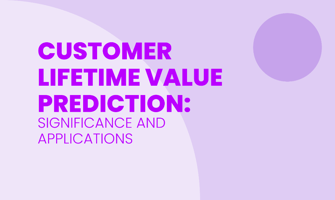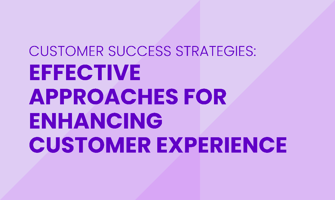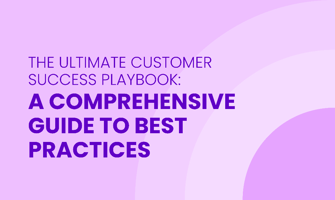Understanding how much a customer is worth throughout their relationship with a business is...
Customer Success Best Practices: Proven Strategies for Maximizing Retention
Customer Success can affect a business's relationship with its customers. This guide shows how to keep your customers happy and loyal with simple strategies.
You'll learn about:
Mapping the customer journey
Optimizing onboarding
Reducing churn
You'll also get tips from industry experts on:
Improving customer interaction
Personalization
Using feedback
These strategies can help boost retention rates, grow revenue, and strengthen customer relationships.
Understanding Customer Success
To measure customer success well, businesses should watch customer success metrics. These include health scores, retention rates, and customer satisfaction.
Understanding customer goals helps align their objectives with company goals. This improves the customer journey and reduces churn.
Customer feedback is also important. It provides actionable insights and points out areas for improvement. The customer success team can use this data to enhance the customer experience. They can refine the onboarding process and other touch points.
This is especially important for SaaS businesses with subscription-based models. A digital-first customer success strategy, using automation and video responses, can make interactions easier. An agile approach helps the customer success team stay responsive to changes.
Working with teams like account management and customer support ensures a unified strategy. By focusing on user experience and using automated tracking, companies can optimize upsell and cross-sell opportunities. This also improves overall customer outcomes.
Tools like Custify and CRM systems provide data-driven insights. These help manage the customer lifecycle effectively. This way, businesses can achieve higher revenue, customer satisfaction, and retention.
Building an Effective Customer Success Strategy
Key Elements of a Customer Success Strategy
Developing a strong customer success strategy involves several steps.
First, define a clear onboarding process. This helps set customer expectations and improve the user experience.
Leverage automation and video responses to support a smooth customer journey.
The customer success team, including customer success managers, works with internal teams to ensure good experiences at all customer touch points.
To measure the success of the customer success strategy, track metrics such as:
Health scores
Retention rates
Revenue growth
Use automated tracking and CRM systems to get data-driven insights for SaaS businesses. Regularly check these KPIs to find cross-sell and upsell opportunities, improving overall customer outcomes.
Customer feedback is important for refining the strategy. Set up a feedback loop for continuous improvement. Use insights from customer support interactions and industry trends to inform the team about changing needs.
Aligning product UX with customer expectations can enhance the customer lifecycle in subscription-based business models. This ensures long-term satisfaction and loyalty.
Segmentation: Identifying Customer Groups for Personalized Success
How can customer segmentation help in creating personalized success strategies for different groups?
By segmenting customers, teams can focus on various needs and preferences. With touch points and data-driven insights, the user experience can be improved. For example, a SaaS company can use health scores to monitor customer satisfaction and adjust strategies accordingly.
--Criteria for Effective Segmentation:--
Customer lifecycle stages
User behavior
This helps teams allocate resources efficiently. During onboarding, a tailored plan for each segment ensures a smooth experience.
--Common Challenges in Customer Segmentation:--
Data fragmentation
Lack of automated tracking
--Solutions:--
Use a robust CRM system
Implement automation tools
Agile innovation allows for real-time adjustments based on feedback and outcomes. Effective segmentation leads to higher retention and better customer relationships.
--Improving Customer Success Management:--
Digital-first strategies
Upsell and cross-sell practices
Agile approaches
Tools like Custify and video responses enhance onboarding and customer satisfaction. Automated tracking and clear metrics provide actionable insights for continuous improvement.
Onboarding: Setting Up for Long-term Success
To ensure long-term customer success, the onboarding process should cover all parts of the customer journey. The customer success team should work closely with internal teams to create a clear onboarding process.
This includes:
Setting up automation for repetitive tasks.
Using video responses to engage customers.
Leveraging data-driven insights to personalize the customer experience.
Track metrics such as health scores, customer retention rates, and feedback loops during onboarding to gauge success. Effective onboarding can boost customer satisfaction and retention, especially in SaaS businesses.
By integrating a digital-first customer success approach with agile innovation, CS teams can improve user experience and outcomes.
Strategies like cross-sell and upsell techniques, aligned with a robust CRM and account management system, further enhance the customer lifecycle. Insights from industry experts, such as those from Custify, suggest that a well-executed success strategy, including thorough onboarding, can greatly impact customer relationships, overall revenue, and subscription-based business models.
Proactive Outreach: Engaging Customers before Issues Arise
The customer success team can spot potential issues by using a data-driven approach. This includes automated tracking of customer health scores and CRM systems.
Monitoring these touch points throughout the customer journey helps in finding trends that may signal future problems.
Proactive communication includes:
Video responses
Personalized check-ins
Automated emails during onboarding
These set clear expectations and ensure a consistent user experience.
Feedback loops are important. Insights from these interactions allow the team to adjust the success strategy. This improves customer satisfaction and retention.
Using agile innovation means making quick adjustments based on actionable insights. This keeps customer success strategies effective.
In B2B SaaS, where the model is often subscription-based, leveraging:
Automation
Customer success management
Cross-sell opportunities
These can optimize the customer lifecycle and boost revenue. Engaging customers early with these methods provides a successful experience. This aligns with customer success standards and enhances the customer support function within internal teams.
Using Playbooks and Customer Success Automation
Playbooks can simplify customer success processes by providing consistent steps for meeting customer needs.
For example:
A SaaS company can use a playbook for the onboarding process. This makes sure all new users have the same initial experience.
Using automation tools in customer success strategies has many benefits:
Streamlined communication
Real-time updates on customer health scores
Proactive management of touch points
Examples:
Automated tracking of customer interactions through a CRM can send reminders for the CS team to engage with clients.
Customer success teams can use automation to monitor key metrics like customer satisfaction and retention rates. This helps them find potential issues early.
Automated alerts can notify customer success managers if a user's health score falls. They can then take immediate action.
By using automation and data-driven insights:
Internal teams can provide a personalized user experience.
This leads to better customer outcomes, higher revenue, and improved retention.
These practices align with agile innovation and success strategies in the customer success industry.
Maximizing Renewals and Reducing Churn
Effective Strategies for Renewal Management
Effective renewal management strategies involve tracking key metrics. These include customer health scores, customer satisfaction, and retention rates.
Implement customer feedback through a continuous feedback loop. Automated tracking helps improve future renewals.
Optimize touch points during the customer journey. Use inputs from internal teams like customer success and customer support.
Data-driven strategies help B2B SaaS businesses understand customer segments. Clear communication of the value proposition is important in the onboarding process.
Emphasize product improvements, success stories, and actionable insights. Agile innovation adds dynamism to customer success management. Integrate digital-first customer success and video responses for a personalized approach.
Focus on customer relationships and the lifecycle. Customer success teams can cross-sell and upsell effectively. This enhances overall satisfaction, revenue, and retention rates.
Use automation and an agile approach to adopt best practices seamlessly. This leads to improved customer journeys for subscription-based businesses.
Upsells and Cross-sells: Leveraging Customer Success for Growth
To find prime opportunities for upsells and cross-sells, a customer success team can analyze data from the customer journey, touch points, and health scores.
They track interactions and feedback using automation and CRM tools. Customer feedback shapes upsell and cross-sell strategies. A feedback loop lets the team align offers with customer needs.
For example, a SaaS company can personalize the customer experience with video responses during onboarding and beyond.
Measuring effectiveness involves tracking metrics like retention rates and revenue growth. Businesses can assess success by analyzing satisfaction scores, user experience, and overall outcomes.
Adopting an agile approach, digital-first customer success, and automated tracking helps continuous improvement. Insights suggest investing in product UX and aligning internal teams boosts the effectiveness of these strategies.
Utilizing Customer Touch Points to Enhance Experience
Using different customer touch points can improve the customer experience.
These touch points include:
The onboarding process
Customer support interactions
Automated tracking through CRMs
The customer success team can gather useful insights from these touch points to deliver a great experience.
Effective strategies include:
Using data-driven methods
Setting up feedback loops to refine the customer journey
Tools like video responses and health scores can add a personal touch. The CS team can also identify upsell and cross-sell opportunities.
A digital-first customer success approach, combined with agile innovation, helps SaaS companies keep high retention rates and increase revenue. Feedback from various touch points makes the customer success strategy stronger. This improves the user experience and boosts customer satisfaction.
Internal teams like account management and customer success managers must work closely. They need to align their activities with the company’s business model, whether it’s subscription-based or another model, to manage the customer lifecycle efficiently.
Customer Journey Mapping: Visualizing Success Pathways
Customer journey mapping helps identify key touchpoints where customers succeed and face challenges.
Maps show each interaction from onboarding to account management. This allows the Customer Success Team to see what works and what doesn’t.
Visual tools like CRM systems and customer feedback loops provide actionable insights. They ensure a full view of the customer experience from start to finish.
A digital-first customer success approach uses automation and health scores. This helps personalize the journey.
Mapping helps with the success strategy by informing decisions that prioritize user experience and customer outcomes. This enhances customer satisfaction.
For subscription-based models like SaaS companies, agile innovation and automated tracking help retain customers. They improve touchpoints and reduce churn.
Aligning internal teams with a data-driven customer success strategy ensures high retention rates. It also reveals upsell and cross-sell opportunities.
By improving key success metrics and customer segments, businesses can optimize the customer lifecycle. This boosts revenue and shows the value of journey mapping in customer success.
Implementing SaaS Best Practices for Retention
A SaaS company can use data-driven retention strategies by evaluating customer success metrics. These metrics include health scores and customer satisfaction rates.
Tools like Custify can help track these metrics and offer actionable insights to the customer success team. Customer feedback is important for refining retention tactics. By creating a feedback loop, the company can make continuous improvements. This ensures that the customer experience meets expectations.
Personalized communication channels enhance engagement. Examples include video responses and targeted touch points during the customer journey. A tailored onboarding process improves user experience and helps with upsell and cross-sell opportunities.
Automation in CRM allows the customer success manager to efficiently manage account management. This ensures a smooth customer lifecycle.
Successful retention in SaaS businesses requires a strong customer success strategy. This strategy should focus on digital-first customer success and agile innovation. Insights from the customer success industry highlight the importance of aligning internal teams and using automated tracking. These practices boost retention rates and drive revenue.
Agile Innovation: Adapting to Changing Customer Needs
Organizations can integrate Agile methods by focusing on people over processes. They should also pay attention to customer outcomes and be responsive to changes during the customer lifecycle.
This Agile approach helps customer success teams. They can use real-time data and automated tracking to make quick adjustments. Personalized experiences for customers are easier to manage.
Customer feedback is very important. It drives Agile innovation. Using feedback loops, health scores, and CRM tools helps improve the onboarding process, user experience, and product UX.
To get better insights, companies can use video responses and touch points during the customer journey. This helps align with customer success strategies.
Cross-functional teams can address changing demands. These teams include customer success managers and account managers. They share insights and align goals with customer success metrics. This improves customer satisfaction and retention rates.
By focusing on customer segments and using technology, SaaS companies can effectively upsell and cross-sell. This drives revenue growth. A smooth customer support experience and data-driven decision-making help internal teams match their strategies with customer preferences.
This creates a successful experience in B2B SaaS businesses.
Leveraging Resources for Customer Success
Utilizing Technology and Tools
Using technology and tools can improve customer success strategies. For instance, CRM software helps teams track every step in the customer journey.
This gives insights into customer behaviors and needs. Automated tools can monitor customer health scores and predict churn. This allows teams to act early to prevent issues.
Look for tools that integrate with existing systems, support video responses, and provide strong data analytics. Using various tools, like automation in support or cross-sell strategies, offers a smooth customer experience.
SaaS companies gain from digital-first approaches where automation and innovation make onboarding easier. This leads to better customer retention and revenue.
In a subscription-based business, sharing customer success metrics and feedback among teams builds a stronger foundation for customer satisfaction and loyalty.
Training and Development for Customer Success Teams
Training and development for customer success teams should focus on several key skills:
Understanding the customer journey
Identifying touch points
Measuring customer success metrics
These skills help team members improve the customer experience and increase customer retention.
Development programs should include:
Digital-first customer success strategies
Adaptation to changing trends in SaaS businesses
An agile approach can:
Incorporate automated tracking
Use data-driven methods to capture actionable insights
Mentorship and peer learning are also valuable. They offer practical knowledge sharing and create a culture of continuous improvement.
Tools like Custify can:
Connect internal teams
Streamline the onboarding process
Interactive methods such as video responses and CRM systems enrich the user experience. They also support upsell and cross-sell opportunities.
Focusing on customer satisfaction and health scores helps the customer success team impact revenue and retention rates. This is especially important for subscription-based business models.
Investing in product UX and feedback loops ensures positive experiences for all customer segments.
FAQ
What are some key customer success best practices for maximizing retention?
Key customer success best practices for maximizing retention include proactive communication, personalized onboarding, regular check-ins, and providing ongoing value through product updates and educational resources. For example, sending personalized emails with tips and best practices can help customers succeed with the product.
How can businesses effectively measure customer success?
Businesses can effectively measure customer success by implementing key performance indicators (KPIs) such as customer satisfaction scores, customer retention rates, and Net Promoter Score (NPS). Conducting regular customer feedback surveys and analyzing customer data also helps in measuring and improving customer success.
What role does proactive communication play in customer success best practices?
Proactive communication in customer success best practices helps build trust, prevent issues, and anticipate customer needs. Examples include regular check-ins, providing product updates, and offering personalized recommendations.
What are some strategies for identifying and addressing customer pain points?
Some strategies include conducting surveys, analyzing customer complaints, monitoring social media feedback, tracking customer interactions, and implementing customer journey mapping to better understand pain points. Addressing these pain points through improved products/services and providing personalized solutions can lead to higher customer satisfaction.
How can businesses build strong relationships with their customers to improve retention?
Businesses can build strong relationships with customers by providing excellent customer service, personalized interactions, and loyalty programs. They can also gather feedback and implement changes based on customer preferences. This will increase customer satisfaction and improve retention rates.




